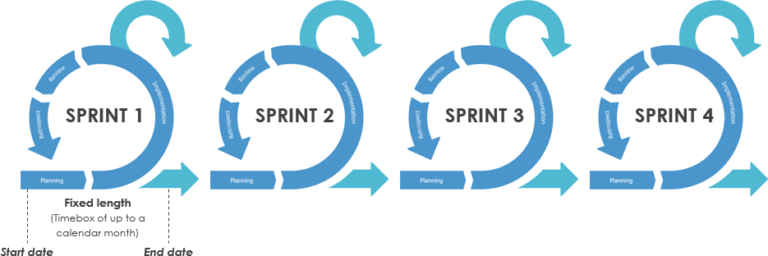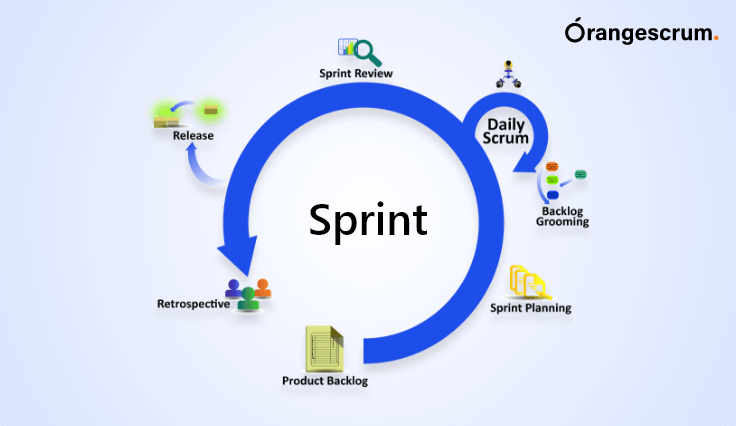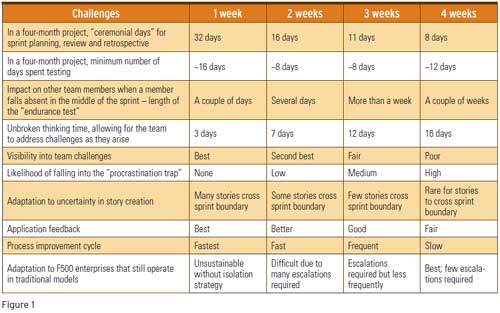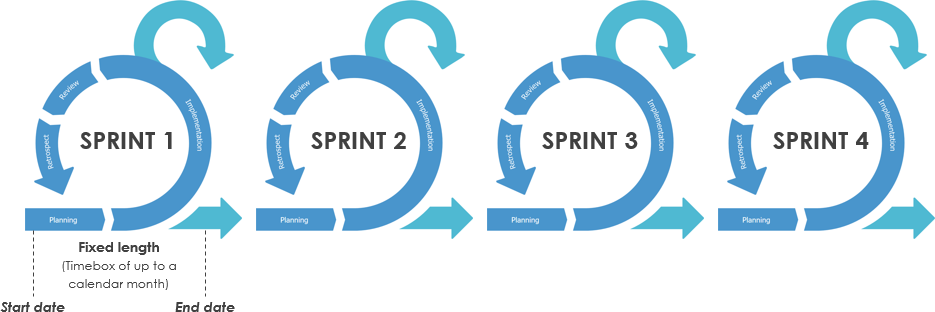
Ideal Scrum
Ideal Scrum
Factors to Consider in Determining Sprint Length
When determining the ideal length for a Scrum sprint, there are several factors that should be considered. These factors can help teams determine the most effective sprint length for their specific circumstances. Some of the key factors to consider include:
- Shorter Sprints for Quicker Feedback and Adaptability
Shorter sprint lengths, such as one week or less, can provide teams with quicker feedback and increased adaptability. This allows teams to make necessary adjustments and improvements more frequently, leading to a more efficient and effective development process. However, it is important to ensure that the shorter sprint length still allows enough time to complete valuable work.
- Longer Sprints for In-Depth Work
On the other hand, longer sprint lengths, such as four weeks or more, can allow teams to engage in more in-depth work. These longer sprints provide teams with the opportunity to tackle complex or large-scale projects that may require more time to complete. However, there is a risk of losing focus or delaying feedback with longer sprints, so it is important to carefully assess the trade-offs.
- Team’s Ability to Deliver a Potentially Releasable Product Increment
The team’s ability to deliver a potentially releasable product increment is another important consideration when determining sprint length. The sprint length should align with the team’s capacity and capabilities to ensure that they can consistently deliver valuable and functional increments at the end of each sprint.
- Complexity of the Project
The complexity of the project also plays a role in determining the ideal sprint length. More complex projects may require longer sprints to accommodate the additional time needed for planning, development, and testing. Conversely, less complex projects may be suitable for shorter sprints that enable faster iteration and feedback.
- Level of Customer Involvement
The level of customer involvement in the development process can also influence the sprint length. Projects with high customer involvement may benefit from shorter sprints, as they allow for more frequent feedback and collaboration. On the other hand, projects with minimal customer involvement may require longer sprints to accommodate the reduced need for immediate feedback.
Speak to MCTC today about our consultancy advice and training packages.

This image is property of blog.orangescrum.com.
Adjusting Sprint Length Over Time
The ideal sprint length may need to be adjusted over time as the team learns and adapts to their specific circumstances. It is important to regularly evaluate and assess the effectiveness of the current sprint length and make adjustments as needed. This may involve experimenting with different sprint lengths and soliciting feedback from team members and stakeholders. By continuously improving the sprint length, teams can optimize their development process and achieve better results.
Duration of Sprints in Scrum
According to the Scrum Guide, the duration of sprints in Scrum should be short, preferably no longer than one month. This short duration allows for more frequent feedback loops and ensures the timely delivery of value to customers. It also encourages faster iterations and enables teams to quickly respond to changes and requirements.

This image is property of www.methodsandtools.com.
Benefits of Shorter Duration Sprints
There are several benefits to adopting shorter duration sprints in Scrum. Some of these benefits include:
- Increased Adaptability: Shorter sprints allow teams to quickly adapt to changes in requirements or priorities. This flexibility enables the team to make necessary adjustments and improvements more frequently.
- Faster Feedback Loops: Shorter sprints facilitate faster feedback loops between the team and stakeholders. This rapid feedback enables the team to receive valuable input and make necessary changes in a timely manner.
- Higher Customer Satisfaction: Delivering value more frequently through shorter sprints can lead to higher customer satisfaction. Customers can see the progress and impact of the team’s work sooner, which enhances their overall experience.
- Improved Team Collaboration: Shorter sprints encourage close collaboration and communication within the team. By working in shorter cycles, team members can stay engaged and aligned with shared goals, leading to increased productivity and efficiency.
Different Team Dynamics and Sprint Durations
It is important to note that different team dynamics may require different sprint durations. Factors such as team size, experience level, and availability can influence the ideal sprint length for a particular team. It is essential to consider these unique factors and customize the sprint length accordingly to optimize team performance and outcomes.

This image is property of www.visual-paradigm.com.
Things to Consider
When determining the ideal sprint duration, there are several important factors that should be taken into account. These factors can help teams make informed decisions and ensure that the chosen sprint duration aligns with their specific needs and goals. Some of the key factors to consider include:
- Time Spent in Meetings: Sprint duration should take into consideration the amount of time spent in meetings. Longer sprint durations may require more time dedicated to meetings, such as planning, review, and retrospective sessions.
- Stakeholder Feedback: The frequency and necessary involvement of stakeholders in the development process should be considered when determining sprint duration. Projects with frequent and critical stakeholder feedback may benefit from shorter sprint durations.
- Overall Velocity: The team’s velocity, or the amount of work they can reasonably accomplish within a sprint, should be factored in when deciding on the sprint duration. If the team consistently struggles to meet sprint goals, it may be a sign that the sprint duration is too short.
- Designing and Conducting Experiments: Experimenting with different sprint durations can provide valuable insights and data to inform the decision-making process. Designing and conducting experiments allows teams to gather objective information about the impact of different sprint durations on productivity and outcomes.
- Stating a Hypothesis: When conducting experiments, it is important to state a clear hypothesis that can be tested and measured. The hypothesis should reflect the expected impact of changing the sprint duration and serve as a benchmark for evaluating the results.
- Collecting Data: To assess the impact of different sprint durations, teams should collect relevant data throughout the experiment. This data can include metrics such as team productivity, stakeholder satisfaction, and overall project success.
- Analyzing Results: Once the data is collected, it is important to analyze the results objectively and identify any trends or patterns. By analyzing the results, teams can gain insights into the effectiveness of different sprint durations and make data-driven decisions.
- Repeatable Data and Unintended Consequences: When conducting experiments, it is crucial to ensure that the data collected is repeatable and can be consistently measured. Additionally, teams should consider any unintended consequences that may arise from changing the sprint duration and address them accordingly.
Conclusion
Finding the ideal sprint length for a Scrum team is essential for optimizing productivity and achieving successful outcomes. By considering factors such as team dynamics, project complexity, and customer involvement, teams can determine the most effective sprint duration. Experimentation and continuous improvement are key to refining and adapting the sprint duration over time. Through careful analysis of data and feedback, teams can make informed decisions that promote collaboration, adaptability, and customer satisfaction.

This image is property of www.edgeagility.com.
